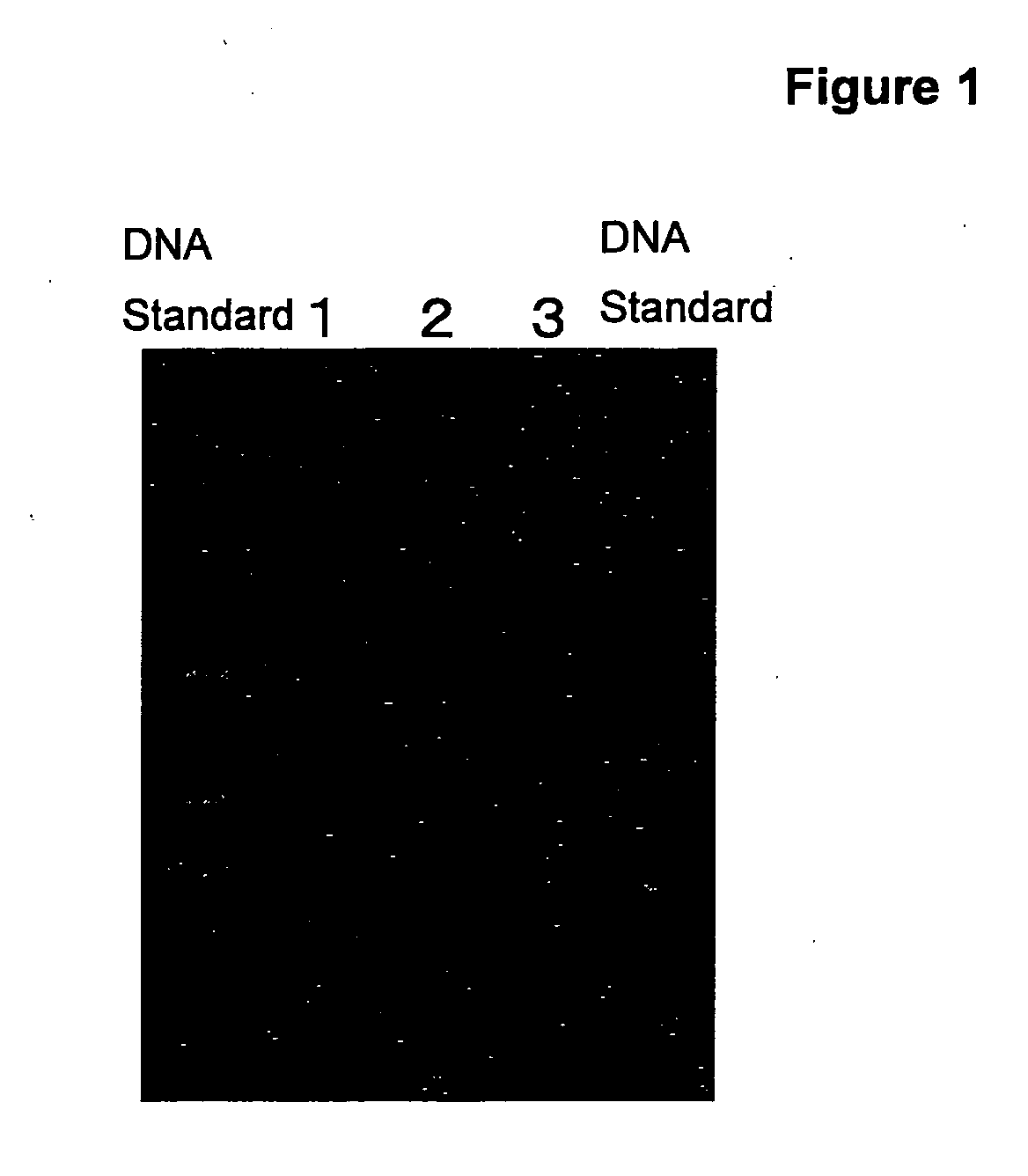Methods for stably retaining foreign genes in cells
a foreign gene and cell technology, applied in the field of stably retaining foreign genes within cells, can solve the problem of strictly limited composition of fermentation medium, and achieve the effect of stabilizing the recombinant vector without restricting the composition of the medium
- Summary
- Abstract
- Description
- Claims
- Application Information
AI Technical Summary
Benefits of technology
Problems solved by technology
Method used
Image
Examples
embodiment 4
[Embodiment 4] Introducing Plasmid Having a Kanamycin Resistance Gene into Strain DTS1451
[0116]Using primers C and D with the chromosome of Bacillus subtilis strain ISW1214 as template, a DNA fragment containing the tryptophanyl-tRNA synthetase gene and nearby regions was obtained. This DNA fragment was digested with XhoI restriction enzyme and spliced with pDA2 that had been predigested with the restriction enzyme XhoI. This was then used to transform Escherichia coli strain HB101. Plasmid was prepared from the transformant obtained and named pDATS13. Using primers Q and R with general purpose plasmid pUB110 as template, a DNA fragment containing the kanamycin resistance gene and nearby regions was obtained. This DNA fragment was digested with EcoRI, amplified by PCR using primers S and T with pDATS14 as template, and then spliced with the DNA fragment obtained by digestion with EcoRI. It was then used to transform Escherichia coli strain HB101. Plasmid was prepared from the transf...
embodiment 5
[Embodiment 5] Producing Cellulase in DTS1451
[0117]A PCR reaction was conducted using primers U and V with the chromosome of Bacillus akibai strain 1139 (JCM 9157T), a cellulase-producing bacterium (see J. Gen. Microbiol. 1986, 132, 2329-2335, Fukumori et al.; Int J Syst Evol Microbiol. (2005) 55: 2309-15. Nogi, Y. et al.; these descriptions are hereby incorporated in their entirety by reference) as template to obtain a DNA fragment containing cellulase and nearby regions. This DNA fragment and pDATS13 were digested with the restriction enzyme BamHI and then spliced to obtain plasmid pDATSC1. This plasmid was employed to transform DTS1451(pDATSK) and selection was conducted with a regenerated medium containing tetracycline. The transformants obtained were inoculated onto kanamycin-containing LB agar medium and regenerated medium containing 7.5 microgram / mL of tetracycline. A strain that exhibited cellulase activity, was sensitive to kanamycin, and was resistant to tetracycline was n...
embodiment 6
[Embodiment 6] The Retention of Plasmid pDATSC1 in Strain DTS1451
[0118]Strain DTS1451 containing pDATSC1 was inoculated into LB media to which 7.5 micrograms / mL of tetracycline had been added or into which no tetracycline had been added (1 percent polypeptone, 0.5 percent yeast extract, and 1 percent sodium chloride) and cultured with stirring at 130 rpm for 24 hours at 30° C. A 10 microliter quantity of the culture solution was collected and transplanted to another 100 mL of LB medium. Culturing was conducted for another 24 hours. A 10 microliter quantity of the culture solution was collected, transplanted to another 100 mL of LB medium, and similarly cultured for 24 hours. Subsequently, operations were conducted to recover the plasmid from the cultured cells. As a result, in the DTS1451 strain containing pDATSC1, regardless of whether tetracycline was added or not, no change was observed in the content of plasmid per the culture solution. In the mutant strain of Bacillus subtilis ...
PUM
 Login to View More
Login to View More Abstract
Description
Claims
Application Information
 Login to View More
Login to View More - R&D
- Intellectual Property
- Life Sciences
- Materials
- Tech Scout
- Unparalleled Data Quality
- Higher Quality Content
- 60% Fewer Hallucinations
Browse by: Latest US Patents, China's latest patents, Technical Efficacy Thesaurus, Application Domain, Technology Topic, Popular Technical Reports.
© 2025 PatSnap. All rights reserved.Legal|Privacy policy|Modern Slavery Act Transparency Statement|Sitemap|About US| Contact US: help@patsnap.com

